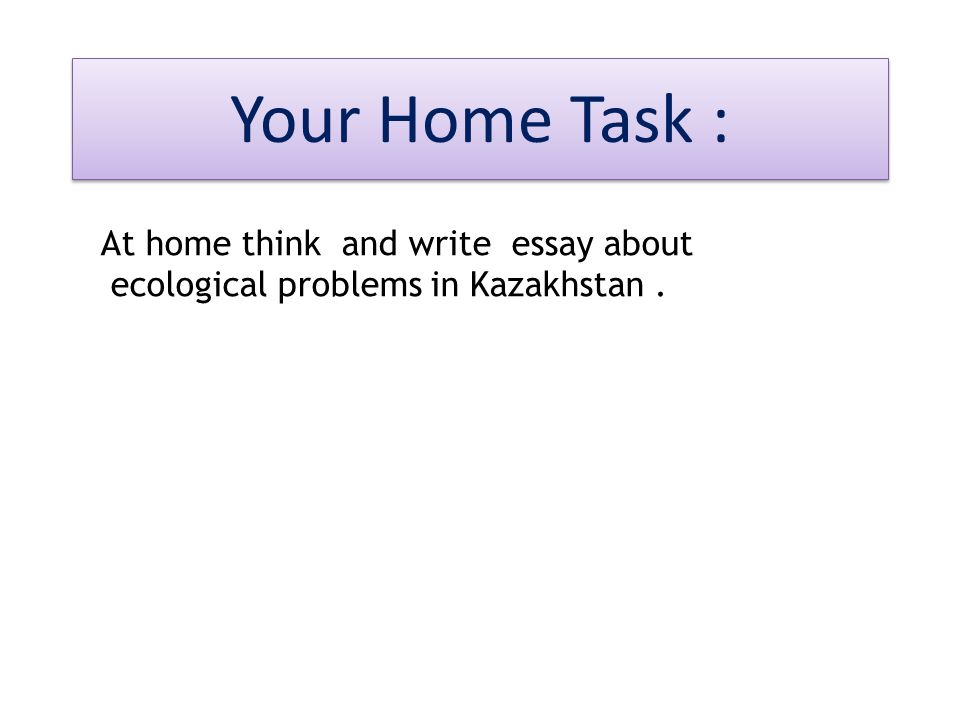Ecological Problem In Kazakhstan Topic
Kazakhstan faces several important environmental issues. As the site of the former Soviet Union's nuclear testing programs, areas of the nation have been exposed to high levels of nuclear radiation, and there is significant radioactive pollution. The nation also has 30 uranium mines, which add to the problem of uncontrolled release of radioactivity.
Ecological Problems Of Kazakhstan. Ecological Problems Chapter 1 Ecology is a very popular word today. But what does it mean? Ecology is a since which studies the relationship between all forms of life on our planet and the environment. This word came from Greek “oikos” which means home.
Once the cleaning process is complete, AdwCleaner will ask to restart your computer, please do so. Right click on the Adwcleaner.exe and select run as admin. Once it's done scanning, make sure that every item listed in the different tabs is checked and click on the Clean button. After the restart, a log will open. Accept the EULA Click Scan now. Idm 607 extension for chrome firefox.
Kazakhstan has sought international support to convince China to stop testing atomic bombs near its territory, because of the dangerous fallout. Mismanagement of irrigation projects has caused the level of the Aral Sea to drop by 13 m, decreasing its size by 50%. The change in size has changed the climate in the area and revealed 3 million hectares of land that are now subject to erosion. Air pollution in Kazakhstan is another significant environmental problem.
Acid rain damages the environment within the country and also affects neighboring countries. In 1992 Kazakhstan had the world's 14th highest level of industrial carbon dioxide emissions, which totaled 297.9 million metric tons, a per capita level of 17.48 metric tons. In 1996, the total had dropped to 173.8 million metric tons. Pollution from industrial and agricultural sources has also damaged the nation's water supply. UN sources report that, in some cases, contamination of rivers by industrial metals is 160 to 800 times beyond acceptable levels.
Pollution of the Caspian Sea is also a problem. Kazakhstan's wildlife is in danger of extinction due to the overall level of pollution. According to current estimates, some areas of the nation will not be able to sustain any form of wildlife by the year 2015. In the areas where pollution is the most severe, 11 species of mammals and 19 species of birds and insects are already extinct.

As of 2001, 15 mammal species, 15 bird species, 5 types of freshwater fish, and 36 species of plant are listed as threatened. Threatened species include the argali, Aral salmon, great bustard, snow leopard, and tiger. The mongolian wild horse has recently become extinct in the wild.
This article needs additional citations for. Unsourced material may be challenged and removed. Find sources: – ( March 2008) () has serious environmental issues such as radiation from nuclear testing sites, the shrinking of the Aral sea, and of former agricultural land. These issues are due in large part to Kazakhstan's years under the. Partly because of the country's enormous semi-arid, the Soviet government used as its site. Along with near-absent, this has contributed to an alarmingly high rate of in many rural areas. Kazakhstan has identified at least two major within its borders: the shrinking of the, and at the nuclear testing facility (in fact a large zone south of ()) and along the Chinese border.

The is located in Kazakhstan, which fosters regional cooperation on environmental issues. Most of ’s water supply has been polluted by industrial and agricultural runoff and, in some places,.
The, which is shared with, has shrunk to three separate bodies of water because of water drawdowns in its tributary rivers. A Soviet-era biological weapons site is a threat because it is located on a former island in the Aral Sea that is now connected with the mainland. The reduction in the Aral Sea’s water surface has exacerbated regional climatic extremes, and agricultural soil has been damaged by salt deposits and eroded by wind.
Desertification has eliminated substantial tracts of agricultural land. Plants in industrial centers lack controls on effluents into the air and water. The Semey region in the northeast has long-term radiation contamination from Soviet-era weapons testing. The Ministry of Environmental Protection is underfunded and given low priority. Some new environmental regulation of the oil industry began in 2003, but new oil operations on Kazakhstan’s Caspian coast add to that sea’s already grave pollution.
International programs to save the Aral and Caspian seas have not received meaningful cooperation from Kazakhstan or other member nations. Aral Sea [ ] The covers 68,000 square kilometres (26,300 sq mi) with Kazakhstan to the north and Uzbekistan to the south. Soviet irrigation projects begun in the 1960s and other environmental challenges have severely depleted this once massive inland sea and by 2007, it had shrunk to 10 percent of its original size. Efforts to revive the Aral Sea [ ] The efforts included Syr Darya Control & Northern Aral Sea (NAS) project. The $86 million NAS project, funded jointly by the World Bank through a loan of $65 million and the Government of Kazakhstan which covered the rest, was designed to mitigate the environmental and economic damage to the region, sustain and increase agriculture and fishing in the Syr Darya basin and secure the continued existence of the Northern Aral Sea (also known as the Small Sea) by improving environmental and ecological conditions in the delta area. In addition, three revival programs were designed for implementation in the Aral Sea Basin (ASBP 1, ASBP 2 and ASBP 3).